CEEESA Environmental Analysis Tools
The Center for Energy, Environmental, and Economic Systems Analysis (CEEESA) provides energy systems analysis tools that cover a wide range of issues. The table below summarizes the available models. Click on each model name to get more information.
Energy and Power Evaluation Program (ENPEP) - BALANCE Module
 The Windows version of the Energy and Power Evaluation Program (ENPEP-BALANCE) is the premier energy systems analysis software in use in over 80 countries. ENPEP-BALANCE
was developed by CEEESA with support from the U.S. Department of
Energy. ENPEP-BALANCE allows users to evaluate the entire energy system (supply and demand side) and the environmental implications of different energy strategies. The
latest ENPEP-BALANCE version takes full advantage of the Windows operating environment. The Windows version of the Energy and Power Evaluation Program (ENPEP-BALANCE) is the premier energy systems analysis software in use in over 80 countries. ENPEP-BALANCE
was developed by CEEESA with support from the U.S. Department of
Energy. ENPEP-BALANCE allows users to evaluate the entire energy system (supply and demand side) and the environmental implications of different energy strategies. The
latest ENPEP-BALANCE version takes full advantage of the Windows operating environment.
The nonlinear equilibrium ENPEP-BALANCE model matches the demand for energy with available resources and technologies. Its market-based simulation approach allows ENPEP-BALANCE to determine the responses of various segments of the energy system to changes in energy prices and demand levels. The model relies on a decentralized decision-making process in the energy sector, and it can be calibrated to the different preferences of energy users and suppliers. ENPEP-BALANCE uses a network that consists of different nodes and links, which represent various energy systems. Nodes in the network represent depletable and renewable resources, various conversion processes, refineries, thermal and hydro power stations, cogeneration units, boilers and furnaces, marketplace competition, taxes and subsidies, and energy demands. Links connect the nodes and transfer information among nodes.
ENPEP-BALANCE is very versatile in that the analyst starts with an empty workspace and builds an energy system configuration of nodes and links. ENPEP-BALANCE's powerful graphical user interface makes it as easy as “drag and drop” to build networks of regional, national, or multinational scope. Drop-down menus can be used to display model inputs and results directly within the energy network. Double-clicking the nodes allows access to more detailed information. The latest ENPEP-BALANCE version also incorporates calculations of environmental residuals, such as atmospheric pollution, water effluents, and waste generation. ENPEP-BALANCE is used extensively in the global community to conduct greenhouse gas mitigation analyses, energy policy studies, and natural gas market analyses.
Click here for more details on the ENPEP-BALANCE model.
For more information about Energy and Power Evaluation Program (ENPEP-BALANCE), contact CEEESA.
Wien Automatic System Planning Package (WASP)
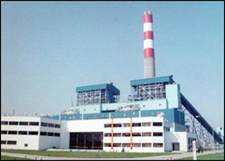 This widely used model analyzes generating system expansion options, primarily to determine the least costly expansion path that will adequately meet the demand for electric power, subject to user-defined constraints. To measure the economic performance of alternate expansion plans, WASP uses the present value of total system costs, including the capital cost of new generating units, fixed/variable operation and maintenance costs, fuel costs, and costs of unserved energy. This widely used model analyzes generating system expansion options, primarily to determine the least costly expansion path that will adequately meet the demand for electric power, subject to user-defined constraints. To measure the economic performance of alternate expansion plans, WASP uses the present value of total system costs, including the capital cost of new generating units, fixed/variable operation and maintenance costs, fuel costs, and costs of unserved energy.
Probabilistic simulation is used to calculate the production costs and reliability parameters for numerous possible future system configurations. A dynamic programming technique is used to determine an economically optimal expansion path for the electric power system under consideration. System reliability is evaluated on the basis of three indices: reserve margin, loss-of-load-probability, and unserved energy. These indices, along with the maximum number of thermal or hydroelectric units that can be added each year, are user-specified constraints required for acceptance of an expansion plan.
WASP’s modular structure permits users to monitor intermediate results during the iterative optimization process. A new Windows version (WASP-IV) is now available. WASP-IV considers pumped-storage plants; allows specification of a fixed maintenance schedule for units in the system; computes atmospheric emissions; and introduces new constraints on total emissions,
fuel consumption, and electricity generation. WASP was developed and is distributed by the International Atomic Energy Agency. Argonne provides technical support.
For more information about Wien Automatic System Planning Package (WASP), contact CEEESA.
Argonne Production, Expansions, and Exchange (APEX) Model for Electrical Systems
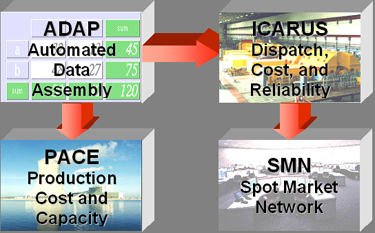 APEX integrates several modules that are used to evaluate production costs, reliability, transmission, and expansion alternatives for electric utilities. These modules are set up to transfer data among themselves. User‑friendly menu systems allow for information input and evaluation of results. APEX integrates several modules that are used to evaluate production costs, reliability, transmission, and expansion alternatives for electric utilities. These modules are set up to transfer data among themselves. User‑friendly menu systems allow for information input and evaluation of results.
For more information about Argonne Production, Expansions, and Exchange (APEX) Model for Electrical Systems, contact CEEESA.
Greenhouse Gases, Regulated Emissions and Energy Use in Transportation (GREET)
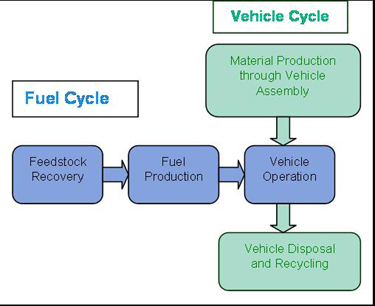 Designed to analyze the energy and emission effects of new transportation technologies and the use of alternative transportation fuels, GREET evaluates technologies on the basis of what is commonly referred to as the “total energy cycle.” It estimates per-mile energy-cycle emissions and energy use of both near- and long-term transportation technologies, while calculating energy-cycle emissions for five criteria pollutants and three greenhouse gases. The model also calculates the total energy, fossil fuel, and petroleum consumption that results from the use of various transportation fuels. Designed to analyze the energy and emission effects of new transportation technologies and the use of alternative transportation fuels, GREET evaluates technologies on the basis of what is commonly referred to as the “total energy cycle.” It estimates per-mile energy-cycle emissions and energy use of both near- and long-term transportation technologies, while calculating energy-cycle emissions for five criteria pollutants and three greenhouse gases. The model also calculates the total energy, fossil fuel, and petroleum consumption that results from the use of various transportation fuels.
The U.S. Department of Energy’s Office of Energy Efficiency and Renewable Energy has used this full fuel-cycle model in rulings on alternative fuels for light-duty vehicles. Currently, more than 100 organizations use the model and its results, including car manufacturers, oil companies, government agencies, universities, and research institutions in North America, Europe, and Asia.
The GREET model was developed and is distributed by Argonne’s Center for Transportation Research. For more information about the model, click here.
For more information about Greenhouse Gases, Regulated Emissions and Energy Use in Transportation (GREET), contact CEEESA.
Regional Air Pollution Information and Simulation Model for Asia (RAINS-Asia)
RAINS-Asia assesses the effects of atmospheric emissions on human health and ecosystems throughout Asia. Currently, Argonne staff use the model to assess various energy and environmental issues in Asia, especially China. Typically, researchers study energy and coal-use policies and how they influence atmospheric emissions, assemble emission inventories of various species by using energy and other activity data, investigate long-range transport of pollutants in the region, assess the costs of mitigation strategies, estimate the human health impacts of air pollution in Asian cities, and estimate the long-term damage to ecosystems.
The RAINS-Asia model is installed in government agencies throughout Asia as a planning tool. It has also been used by The World Bank and the Asian Development Bank to guide project investment decisions. Developed under funding from The World Bank and the Asian Development Bank, the model is maintained by the International Institute for Applied Systems Analysis in Laxenburg, Austria. Argonne was part of a consortium that initiated the project and helped construct the model.
For more information about Regional Air Pollution Information and Simulation Model for Asia (RAINS-Asia), contact CEEESA.
Tracking and Analysis Framework (TAF)
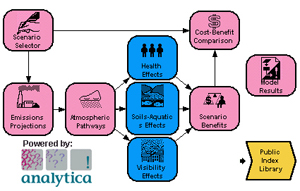 This integrated assessment framework evaluates the status of implementation, the effectiveness, and the costs and benefits of acid deposition control programs such as those created by Title IV of the U.S. 1990 Clean Air Act Amendments. The TAF set of modules includes seven submodels: (1) scenario selector, which specifies alternative control strategies; (2) emissions projections, which determines the emissions of air pollutants on a spatially defined basis; (3) compliance costs, which calculates the costs for each emission source to comply with the control strategy under study; (4) atmospheric pathways, which calculates pollutant dispersion, chemical transformation, and deposition to determine expected concentrations; (5) effects modules, which determine the effects of exposure to the calculated concentrations on health, soils and aquatic environments, visibility, crops, forests, and materials; (6) benefits evaluation, which estimates the monetary value of the effects; and (7) model results, which displays the output of the analyses. This integrated assessment framework evaluates the status of implementation, the effectiveness, and the costs and benefits of acid deposition control programs such as those created by Title IV of the U.S. 1990 Clean Air Act Amendments. The TAF set of modules includes seven submodels: (1) scenario selector, which specifies alternative control strategies; (2) emissions projections, which determines the emissions of air pollutants on a spatially defined basis; (3) compliance costs, which calculates the costs for each emission source to comply with the control strategy under study; (4) atmospheric pathways, which calculates pollutant dispersion, chemical transformation, and deposition to determine expected concentrations; (5) effects modules, which determine the effects of exposure to the calculated concentrations on health, soils and aquatic environments, visibility, crops, forests, and materials; (6) benefits evaluation, which estimates the monetary value of the effects; and (7) model results, which displays the output of the analyses.
Argonne collaborated with ten other institutions in developing TAF. For more information about this model, visit http://www.lumina.com/taf/index.html.
For more information about Tracking and Analysis Framework (TAF), contact CEEESA.
Simplified IMPACTS Analysis (SIMPACTS)
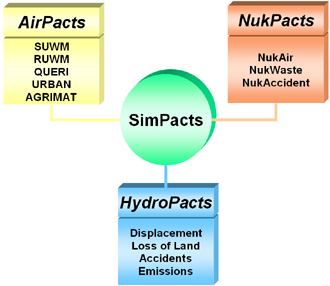 SimPacts consists of three main modules: AirPacts, NukPacts, and HydroPacts. AirPacts estimates the impacts on human health, agricultural crops, and building materials from exposure to routine atmospheric emissions and offers several analytical approaches to do so. NukPacts provides a methodology to quantify and value the adverse effects on human health resulting from routine air emissions of radionuclides from nuclear facilities, routine emissions of radionuclides via waste disposal in the ground, and radionuclide releases resulting from accidents in nuclear facilities. And finally, the HydroPacts module offers a simplified approach to estimate the loss of land and the population displacement from hydropower development, as well as the impacts from dam accidents or failures and emissions during construction and operation of the dam. SimPacts consists of three main modules: AirPacts, NukPacts, and HydroPacts. AirPacts estimates the impacts on human health, agricultural crops, and building materials from exposure to routine atmospheric emissions and offers several analytical approaches to do so. NukPacts provides a methodology to quantify and value the adverse effects on human health resulting from routine air emissions of radionuclides from nuclear facilities, routine emissions of radionuclides via waste disposal in the ground, and radionuclide releases resulting from accidents in nuclear facilities. And finally, the HydroPacts module offers a simplified approach to estimate the loss of land and the population displacement from hydropower development, as well as the impacts from dam accidents or failures and emissions during construction and operation of the dam.
A detailed environmental impacts analysis typically requires a very complex, data-intensive multidisciplinary study, including emissions projections, local and regional dispersion analysis, estimation of physical impacts using exposure-response functions, and monetization of impacts. Large uncertainties often occur because required data are either incomplete or missing.
SIMPACTS provides a simplified approach that helps analysts develop a first estimate of potential damages, both physical and economic. The model is adaptable to data availability because several levels of simplifications have been built in. As more information becomes available (e.g., local population and meteorological statistics), users can develop a more detailed analysis framework. This design is especially valuable to developing countries that have few data available but, over time, may acquire more detailed information. SIMPACTS is currently used in about 30 countries. The model was developed and is distributed by the International Atomic Energy Agency. Argonne’s programs and technical expertise support the use of this software.
For more information about Simplified IMPACTS Analysis (SIMPACTS), contact CEEESA.
|

 The Windows version of the Energy and Power Evaluation Program (ENPEP-BALANCE) is the premier energy systems analysis software in use in over 80 countries. ENPEP-BALANCE
was developed by CEEESA with support from the U.S. Department of
Energy. ENPEP-BALANCE allows users to evaluate the entire energy system (supply and demand side) and the environmental implications of different energy strategies. The
latest ENPEP-BALANCE version takes full advantage of the Windows operating environment.
The Windows version of the Energy and Power Evaluation Program (ENPEP-BALANCE) is the premier energy systems analysis software in use in over 80 countries. ENPEP-BALANCE
was developed by CEEESA with support from the U.S. Department of
Energy. ENPEP-BALANCE allows users to evaluate the entire energy system (supply and demand side) and the environmental implications of different energy strategies. The
latest ENPEP-BALANCE version takes full advantage of the Windows operating environment. This widely used model analyzes generating system expansion options, primarily to determine the least costly expansion path that will adequately meet the demand for electric power, subject to user-defined constraints. To measure the economic performance of alternate expansion plans, WASP uses the present value of total system costs, including the capital cost of new generating units, fixed/variable operation and maintenance costs, fuel costs, and costs of unserved energy.
This widely used model analyzes generating system expansion options, primarily to determine the least costly expansion path that will adequately meet the demand for electric power, subject to user-defined constraints. To measure the economic performance of alternate expansion plans, WASP uses the present value of total system costs, including the capital cost of new generating units, fixed/variable operation and maintenance costs, fuel costs, and costs of unserved energy. APEX integrates several modules that are used to evaluate production costs, reliability, transmission, and expansion alternatives for electric utilities. These modules are set up to transfer data among themselves. User‑friendly menu systems allow for information input and evaluation of results.
APEX integrates several modules that are used to evaluate production costs, reliability, transmission, and expansion alternatives for electric utilities. These modules are set up to transfer data among themselves. User‑friendly menu systems allow for information input and evaluation of results. Designed to analyze the energy and emission effects of new transportation technologies and the use of alternative transportation fuels, GREET evaluates technologies on the basis of what is commonly referred to as the “total energy cycle.” It estimates per-mile energy-cycle emissions and energy use of both near- and long-term transportation technologies, while calculating energy-cycle emissions for five criteria pollutants and three greenhouse gases. The model also calculates the total energy, fossil fuel, and petroleum consumption that results from the use of various transportation fuels.
Designed to analyze the energy and emission effects of new transportation technologies and the use of alternative transportation fuels, GREET evaluates technologies on the basis of what is commonly referred to as the “total energy cycle.” It estimates per-mile energy-cycle emissions and energy use of both near- and long-term transportation technologies, while calculating energy-cycle emissions for five criteria pollutants and three greenhouse gases. The model also calculates the total energy, fossil fuel, and petroleum consumption that results from the use of various transportation fuels. This integrated assessment framework evaluates the status of implementation, the effectiveness, and the costs and benefits of acid deposition control programs such as those created by Title IV of the U.S. 1990 Clean Air Act Amendments. The TAF set of modules includes seven submodels: (1) scenario selector, which specifies alternative control strategies; (2) emissions projections, which determines the emissions of air pollutants on a spatially defined basis; (3) compliance costs, which calculates the costs for each emission source to comply with the control strategy under study; (4) atmospheric pathways, which calculates pollutant dispersion, chemical transformation, and deposition to determine expected concentrations; (5) effects modules, which determine the effects of exposure to the calculated concentrations on health, soils and aquatic environments, visibility, crops, forests, and materials; (6) benefits evaluation, which estimates the monetary value of the effects; and (7) model results, which displays the output of the analyses.
This integrated assessment framework evaluates the status of implementation, the effectiveness, and the costs and benefits of acid deposition control programs such as those created by Title IV of the U.S. 1990 Clean Air Act Amendments. The TAF set of modules includes seven submodels: (1) scenario selector, which specifies alternative control strategies; (2) emissions projections, which determines the emissions of air pollutants on a spatially defined basis; (3) compliance costs, which calculates the costs for each emission source to comply with the control strategy under study; (4) atmospheric pathways, which calculates pollutant dispersion, chemical transformation, and deposition to determine expected concentrations; (5) effects modules, which determine the effects of exposure to the calculated concentrations on health, soils and aquatic environments, visibility, crops, forests, and materials; (6) benefits evaluation, which estimates the monetary value of the effects; and (7) model results, which displays the output of the analyses. SimPacts consists of three main modules: AirPacts, NukPacts, and HydroPacts. AirPacts estimates the impacts on human health, agricultural crops, and building materials from exposure to routine atmospheric emissions and offers several analytical approaches to do so. NukPacts provides a methodology to quantify and value the adverse effects on human health resulting from routine air emissions of radionuclides from nuclear facilities, routine emissions of radionuclides via waste disposal in the ground, and radionuclide releases resulting from accidents in nuclear facilities. And finally, the HydroPacts module offers a simplified approach to estimate the loss of land and the population displacement from hydropower development, as well as the impacts from dam accidents or failures and emissions during construction and operation of the dam.
SimPacts consists of three main modules: AirPacts, NukPacts, and HydroPacts. AirPacts estimates the impacts on human health, agricultural crops, and building materials from exposure to routine atmospheric emissions and offers several analytical approaches to do so. NukPacts provides a methodology to quantify and value the adverse effects on human health resulting from routine air emissions of radionuclides from nuclear facilities, routine emissions of radionuclides via waste disposal in the ground, and radionuclide releases resulting from accidents in nuclear facilities. And finally, the HydroPacts module offers a simplified approach to estimate the loss of land and the population displacement from hydropower development, as well as the impacts from dam accidents or failures and emissions during construction and operation of the dam.